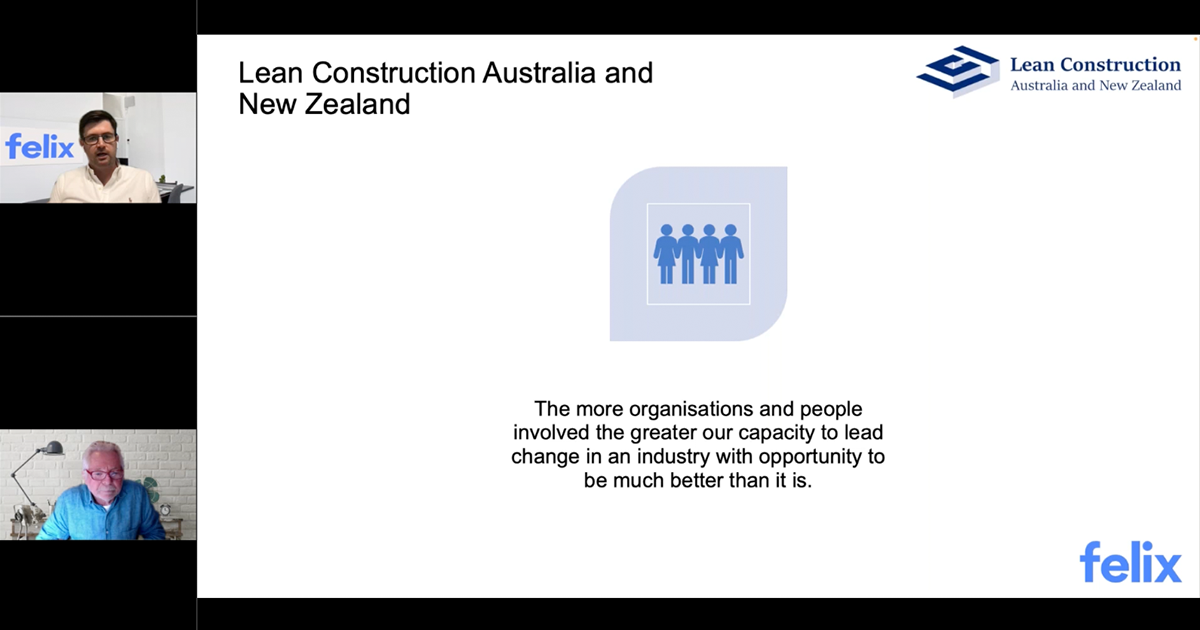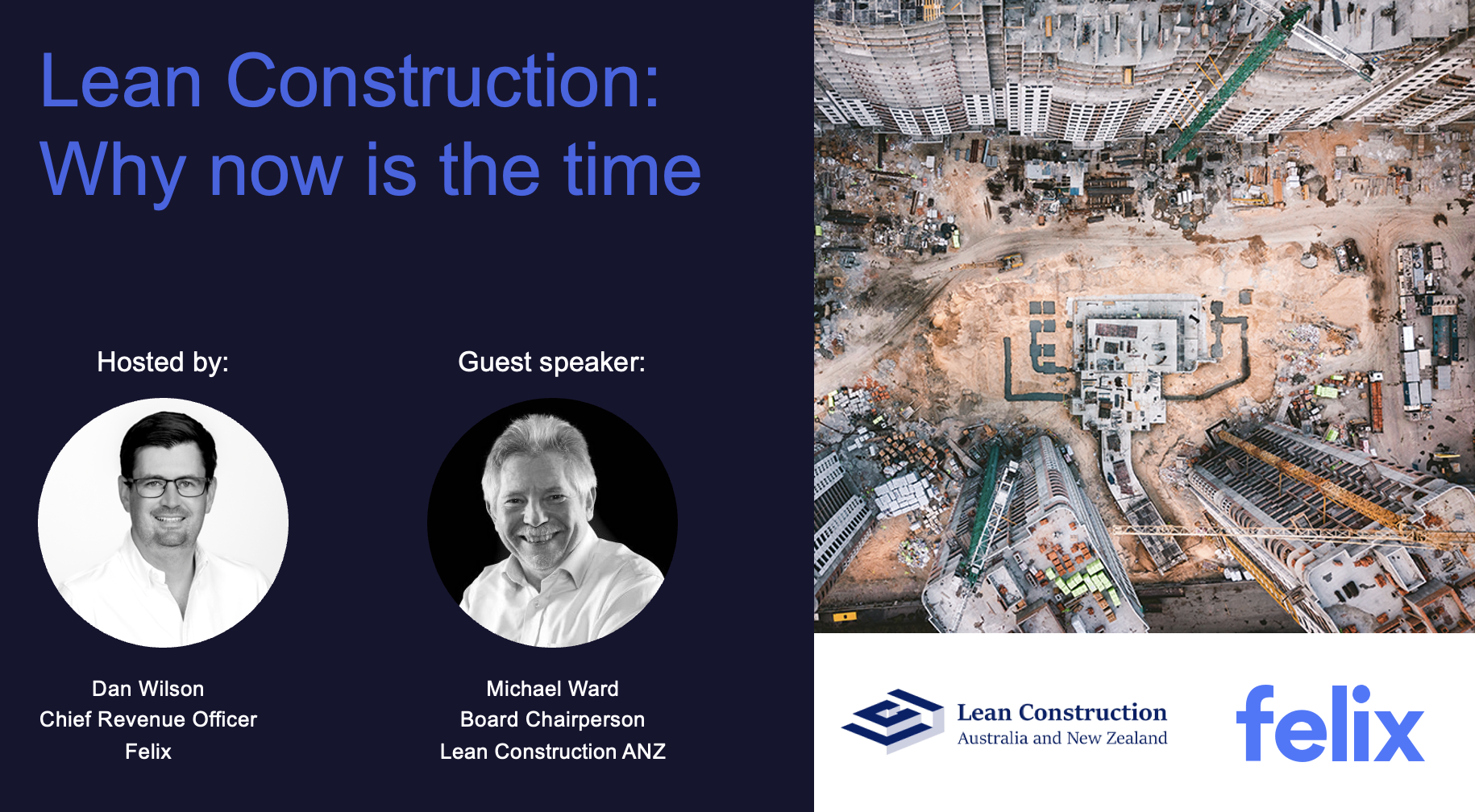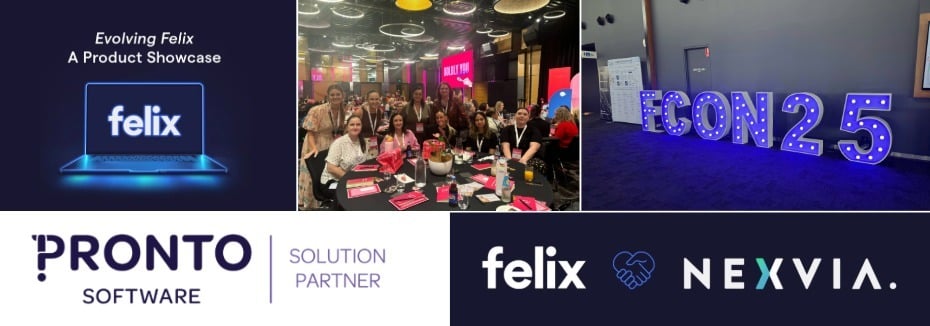In the current environment there's plenty of negativity and fear, and plenty of bad press as well. But the organisations we see are flourishing and will come out on the other side are those that embrace the challenges head on with different ways of thinking and operating. Lean construction is certainly one of those.
I recently had the pleasure of hosting a webinar on Lean Construction with Michael Ward from Lean Construction ANZ. Below is a recap of the Q&A session.
If you’d like to watch the full webinar, please click here.
Q: I'm really keen to understand how we increase the adoption of Lean.
Leadership is a critical element, but like a lot of initiatives, it's really hard to change from the status quo. People are busy, they're doing what they're there to do, whether it be contract or build.
How have you seen organisations get that executive buy-in? You mentioned culture earlier. How do you get that? How do you drive it if you're somebody that's in a role that wants to push this message towards a key decision maker in an organisation?
--
Michael: Well, I think the short answer to that is it hasn't been greatly successful in terms of getting executive leadership to buy in in the Australian context. There are exceptions.
I think it's both the bottom up and the top-down process for success.
And if a project can demonstrate that through the leadership of that project executive and perhaps if it's a collaborative contract environment where the client and then the project director and the design is only determined that they want to implement Lean processes, that can be a place where that leadership then can influence the overall organisation.
The other approach is individuals who have knowledge and experience from other places who are in that executive leadership role recognise the value and then they are able to lead from the top.
So, we're having to manage education to give leaders the confidence to go forward. And the difficulty of cultural change across a large organisation, which we know, can take several years. So magic wand, no silver bullet.
I think a multiple pronged approach, but at a minimum there has to be sponsorship from the executive level and preferably it's active sponsorship rather than benign sponsorship.
How do you do it? The ways that the leaders we have, are through KPIs in terms of individuals and divisions as to the progress they're making; having external support from organisation, Lean coaches to keep driving it.
Again, experiences that we've learned that an organisation gets some Lean coaches in, they make great progress. They get tired of paying for the Lean coaches and say, “look, we're good, we will go on our own now” and without real champions in that organisation it will dwindle.
The clients have a great role to play, particularly government clients. They’re the sources of most of the funding for infrastructure - it's their money they're spending. Perhaps they’d like to spend it better and the opportunity is there for that leadership from the client organisation as we see internationally to say we want these processes in our delivery stream.
--
Q: What do you think that might look like? Would it be the mandating of a particular field of technology or just Lean principles in general?
What have you seen internationally that you think could be adopted by client or government here in Australia?
---
Michael: I think the simplest lever the clients have is in the way they write their contracts and their selection criteria.
If they request in their selection criteria for Lean organisations to have a preferential ranking in the way that they assess their value of their engagement, that's going to drive the supply chain to adopt Lean practices and become leaner in their execution.
So, if 20 or 30% of selection criteria falls on demonstrating competencies in the Lean area, it becomes self-fulfilling.
--
Q: Yeah, I think we're seeing a little bit of that happening, you know the ESG related space, which I'll ask you a little bit about in a moment.
I know that organisations, clients of ours, they're being asked in their tender submissions to identify and prove how they're going to be able to actually identify the suppliers in their supply chain who are 51% Indigenous owned or that are sustainable organisations or not-for-profits or might be as things as simple as how are you going to show us how much diesel you're burning each month?
Some of those key themes and that's where Felix is really helping out.
But what are you seeing in that ESG space? Around how do you think the Lean principles can help an organisation who's got corporate social responsibility at the heart of what they do?
--
Michael: I think they go right in hand, and I agree with you. Putting the KPI performance, with risk and reward against all of the social requirements and environmental requirements, does deliver direct results.
A couple of the projects we’re advising on now are demonstrating their outstanding outcomes by being incentivised to do so and so that's able to be achieved.
Where does Lean fit in? Well, it's inherently aligned with the principles of continuous improvement, improving the outcomes we're looking for in those result areas. It's about greater collaboration with the parties, all participants of the project so it's bringing that element into it.
If we go to the essence of it, as we said at the beginning of this presentation, was that the Lean is in service of value for the customer where the customer sees value in economic and social outcomes. It is going to set the processes in place and deliver those client value assessment criteria.
Watch the full webinar here.

Recent Articles
2025 in review: Milestones, insights and achievements
2025 – a year of that brought meaningful developments for Felix as we continue to address the evolving needs of organisations navigating complex supply-chain environments.
Top 10 reasons for a centralised vendor database
As organisations grow, so does the complexity of managing vendor relationships. Many still rely on spreadsheets or siloed systems, which can lead to inefficiencies, data inconsistencies, and compliance risks. A centralised vendor database offers a smarter, more scalable solution that brings structure, visibility, and control to procurement operations.
Here are the top 10 reasons why centralising your vendor data is a strategic move.
Five ways poor contract storage could be costing your organisation money
Contracts are the backbone of every business relationship – legally binding documents that define expectations, responsibilities, and value.
But what if the way your organisation stores those contracts is quietly costing you money?
Let's stay in touch
Get the monthly dose of supply chain, procurement and technology insights with the Felix newsletter.







